
Initially blockchain was associated with anti-bank and anti-corporation sentiment. However, its universal value has reached far and wide, with even the very entities it seemed to challenge finding opportunities to benefit. One such example is a remittance platform Ripple, which has become a leading provider of blockchain-based solutions for financial institutions.
However, our attention here is not directed at any specific cryptocurrency company, but rather at a specific type of blockchain: the consortium blockchain. It is utilized by groups of corporations to manage data and resources with restricted access. Ripple is a significant example of a consortium blockchain. This article seeks to define consortium blockchains, present additional examples, and highlight their strengths and limitations.
What Is Consortium Blockchain?
Consortium blockchain allows groups of corporations to access, manage, and exchange data and resources that are not readily available to the general public. The data flow within these blockchains necessitates special permission, thereby safeguarding the majority of data from public view. It is apt to describe consortium blockchains as an intermediate link between public and private blockchains.
To gain a deeper understanding of consortium blockchains, it is important to delve into the contrasts between public and private blockchains.
Public blockchains, famously introduced by Bitcoin and further exemplified by Ethereum, are fundamentally permissionless, transparent, and decentralized. They are designed to ensure open access to on-chain data and participation in blockchain governance for everyone.
On the other hand, private blockchains, established by large institutions and corporations, cater to their internal needs, restricting data access solely to a limited circle of employees and maintaining full centralization.
Consortium blockchains stand out due to their unique characteristics: they are decentralized, yet their access is exclusive. These blockchains are conceived by a collective of corporations to offer a blockchain accessible to multiple entities, avoiding complete control by any single entity. Access to data stored within such blockchains is limited to the group of corporations involved.
In summary, consortium blockchains are neither public nor permissionless, yet they provide decentralization, granting equal rights to all participants within the consortium. New members may join the consortium ecosystem with the approval of the existing community.
Consortium blockchains ensure robust data security against external parties. Moreover, their decentralized nature and group management of nodes lead to a reduced load on each company’s node, resulting in enhanced scalability compared to public blockchains.
Image source: ResearchGate
Companies integrate their products with the blockchain through application programming interfaces (APIs). This integration allows consortium members to develop applications based on the shared blockchain and utilize on-chain data. The versatility and security offered by consortium blockchains position them as a robust solution for corporations looking to leverage blockchain technology.
Corporations leveraging the same consortium blockchain obtain a secure space to collaborate with predetermined partners without bearing the technical responsibility of maintaining the entire ecosystem. This arrangement ensures equal access to consensus processes and control for all participants.
Consensus and Governance
Most consortium blockchains utilize the Proof-of-Stake (PoS) or Proof-of-Work (PoW) consensus protocols. Transaction validation in these blockchains is restricted to a specific group of participants, whereas in public blockchains, validation can be performed by anyone with the technical capacity to participate.
Typically, consortium blockchains are governed by specialized groups comprised of representatives from each corporation using the consortium blockchain. The participation is structured to maintain a balanced representation of the involved parties.
Pros and Cons of Consortium Blockchain
Now, let’s outline the advantages and drawbacks of consortium blockchains.
Pros
Fast transactions: Due to the limited number of nodes, consortium blockchains validate transactions more swiftly than public blockchains.
High scalability: Scalability issues are one of the greatest problems in the blockchain sphere. Consortium blockchains are less susceptible to scalability issues, effectively managing large transaction volumes.
Cost efficiency: Resources and financial contributions are collectively distributed among participating companies, leading to reduced individual expenditure.
Enhanced collaboration: A shared working platform facilitates smoother communication and collaboration among corporations.
Limited access: Only the encompassing community can determine who can access consortium blockchains, thereby enhancing their safety and trustworthiness.
Strong security: Restricted accessibility minimizes the risk of unauthorized access and malicious activities, with fewer participants making it easier to identify wrongful actions.
Flexibility: With fewer participants, consortium blockchains enable more effective governance adjustments, enhancing overall efficiency.
Cons
Reduced decentralization: As consortium blockchains have fewer participants, they use less nodes and have a pretty low level of decentralization. It creates a potential risk for some of the involved parties.
Limited adoption: Restricted access results in lower recognition among users and narrower adoption compared to public blockchains.
Complexity: Consortium blockchains are challenging to develop and maintain, typically requiring higher expertise compared to public blockchains.
In essence, consortium blockchains offer secure collaboration for corporations, accompanied by certain challenges that warrant careful consideration.
Consortium Blockchain Examples
Consortium blockchains find applications in various industries such as supply chains, healthcare, energy, finance, and many others.
One prominent example of a consortium blockchain is Ripple. It serves as a platform for facilitating swift and cost-effective cross-border transactions and real-time gross settlement.
XRP among the leading cryptocurrencies by market capitalization
XRP, Ripple’s native token, is among the most popular cryptocurrencies. For some time, it held the highest market cap after Bitcoin, the unparalleled leader in market cap. Notable companies using Ripple include Bank of America, PNC Bank, Santander, American Express, SBI Remit, and Banco Rendimento.
Hyperledger is another notable consortium blockchain launched by the Linux Foundation in 2015. The project aims to unite various companies to develop blockchains and other distributed ledgers to benefit multiple industries, including fintech and supply chains. Additionally, Hyperledger serves as an incubator of codebases from companies like Intel, Digital Asset, and Blockstream. Companies leveraging Hyperledger include Cisco, Fujitsu, Hitachi, IBM, JP Morgan, SWIFT, and Wells Fargo.
Another example is the Energy Web Foundation (EWF), a non-profit organization dedicated to providing blockchain-based solutions for the international energy industry. These solutions are intended to enhance company performance, harness clean energy, improve inter-company cooperation, secure stakeholders’ data, and reduce costs. The foundation introduced the open-source decentralized platform Energy Web Chain in 2017.
Conclusion
Consortium blockchains efficiently blend the best features of public and private blockchains when businesses are led by a consortium of companies. They enable participating parties to contribute to decision-making and enhance the blockchain and associated products on an equitable basis enabled by decentralization. Unlike public blockchains, they prevent unauthorized access to on-chain data or influence over the blockchain structure, ensuring the safety and privacy of data stored on consortium blockchains. Moreover, consortium blockchains offer cost-efficiency, speed, and scalability, which are less common in the blockchain sphere.
As of 2023, consortium blockchains have not gained widespread recognition, although brands such as Ripple and Hyperledger may be familiar to those interested in the cryptocurrency industry. Moreover, despite varying levels of public awareness, these blockchains are in demand among corporations globally. Banks in numerous countries and other companies employ consortium blockchains due to their alignment with corporate needs. However, consortium blockchains also present challenges, including complexity in maintenance and development, as well as concerns regarding their relative centralization.
Related
Stay tuned
Subscribe for weekly updates from our blog. Promise you will not get emails any more often.
Most Popular
New Posts
Stay tuned
Subscribe for weekly updates from our blog. Promise you will not get emails any more often.







